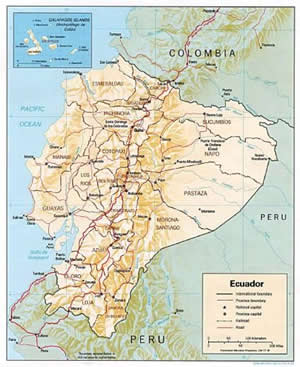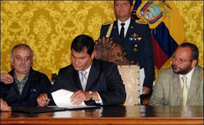| Home > Ecuador |
ECUADOR:
Country Profile of Ecuador
The Republic of Ecuador,is a representative democratic republic in South America, bounded by Colombia on the north, by Peru on the east and south, and by the Pacific Ocean on the west. The country also includes the Galápagos Islands in the Pacific, about 965 kilometers (600 miles) west of the mainland. Ecuador is the Spanish word for equator. Ecuador straddles the equator and has an area of 256,370 square kilometers (98,985 mi²). Its capital city is Quito, however its largest city is Guayaquil.
|
☻Capital: - Quito ☻Area: - Total: 256,370 km² (72nd) 98,985 sq mi - Water (%): 8.8 ☻Independence: - from Spain: May 24, 1822 - from Gran Colombia: May 13, 1830 |
☻Official languages: - Spanish ☻Population: - July 2005 census: 13,228,000 (67th) - Density: 47/km² (147th) 122/sq mi |
Geography of Ecuador:
 The country of Ecuador is divided into three continental areas and one insular region. The Costa, the Sierra, the Oriente and the Galapagos Islands make up this beautiful country. The coast of Ecuador is filled with banana, cacao and coffee plantations with Guayaquil being the biggest city located in this region. The Andes are located there as well with amazing beaches along with the Pacific Ocean. Located in the highlands are volcanoes, mountains and much land. Quito, the capital city of Ecuador is located in the high mountain valley of the Sierra region along with some of the world´s highest eruptible volcanoes. The tropical part of Ecuador is situated in the jungle or namely, the Oriente. It contains beautiful rainforests and rivers and is home to many of the indigenous population that resides in Ecuador. The Galapagos Islands which are located about 1000 kilometers off of the coast were used to expand Charles Darwin´s theories and led to his ideas of natural selection as a means to evolution. The population of Ecuador is roughly 13, 700, 000 people with a total area of 283, 560 square miles with a comparative area that is slightly smaller than Nevada. Ecuador is located to the northwest of South America, bordering both Peru and Columbia.
The country of Ecuador is divided into three continental areas and one insular region. The Costa, the Sierra, the Oriente and the Galapagos Islands make up this beautiful country. The coast of Ecuador is filled with banana, cacao and coffee plantations with Guayaquil being the biggest city located in this region. The Andes are located there as well with amazing beaches along with the Pacific Ocean. Located in the highlands are volcanoes, mountains and much land. Quito, the capital city of Ecuador is located in the high mountain valley of the Sierra region along with some of the world´s highest eruptible volcanoes. The tropical part of Ecuador is situated in the jungle or namely, the Oriente. It contains beautiful rainforests and rivers and is home to many of the indigenous population that resides in Ecuador. The Galapagos Islands which are located about 1000 kilometers off of the coast were used to expand Charles Darwin´s theories and led to his ideas of natural selection as a means to evolution. The population of Ecuador is roughly 13, 700, 000 people with a total area of 283, 560 square miles with a comparative area that is slightly smaller than Nevada. Ecuador is located to the northwest of South America, bordering both Peru and Columbia.
Education in Ecuador:
 Ecuador is a country whose main goal and objective through education is to promote and expand national literacy. Over the years, the school system in Ecuador has progressed to allow disadvantaged social groups, ethnic groups and women to be able to take part more in the educational system. However, like other South American countries, the lack of funds and the rapid growth of population have damaged the ability to have a strong system. Mandatory school attendance was made a law in 1945 that requires all children to attend school between the ages of 6 and 12. Children can receive free education during those six years. Sadly, in rural areas throughout the country, most children drop out of school before the age of 15 in order to stay home and take on more adult responsibilities through work and caring for the family. Secondary education, however, is a bit trickier with overcrowded public institutions and private institutions that encourage usage of other languages. Quito holds one primer university, (although there are other universities throughout the city) the Pontifical Catholic University which stresses research programs in the arts, botany, archaeology, linguistics and anthropology.
Ecuador is a country whose main goal and objective through education is to promote and expand national literacy. Over the years, the school system in Ecuador has progressed to allow disadvantaged social groups, ethnic groups and women to be able to take part more in the educational system. However, like other South American countries, the lack of funds and the rapid growth of population have damaged the ability to have a strong system. Mandatory school attendance was made a law in 1945 that requires all children to attend school between the ages of 6 and 12. Children can receive free education during those six years. Sadly, in rural areas throughout the country, most children drop out of school before the age of 15 in order to stay home and take on more adult responsibilities through work and caring for the family. Secondary education, however, is a bit trickier with overcrowded public institutions and private institutions that encourage usage of other languages. Quito holds one primer university, (although there are other universities throughout the city) the Pontifical Catholic University which stresses research programs in the arts, botany, archaeology, linguistics and anthropology.
Health in Ecuador:
 Both the Ministry of Public Health and the Ecuadorian Social Security Institute are in charge of overseeing the public and private health care system in Ecuador. 80 percent of the population is covered by The Ministry of Health whereas 10 percent is covered by the IESS. In Ecuador, there is a four-tiered system of health care that was starsted and organized by the Ministry of Public Health. Support health-care personnel were posted in small rural areas of less than 1,500 inhabitants with larger communities that were given health-care professionals. The health care in Ecuador has been affected negatively by the lack of training for medical professionals along with few doctors available. However, over the years, healthcare has improved and statistics have shown a drop in infant mortality rates along with child mortality rates. One problem that is still evident in the health care system in Ecuador is the lack of monitoring pregnant women, especially in urban areas. In the 1980´s over 40 percent of women were not monitored during their pregnancy. Fortunately with modern medicine advancing and with The National Commission on Health Human Resources working with the National Health Council, many different institutions have been able to improve in training, management and regulations. This has aided in the quantity and quality of the health workers spread throughout the country.
Both the Ministry of Public Health and the Ecuadorian Social Security Institute are in charge of overseeing the public and private health care system in Ecuador. 80 percent of the population is covered by The Ministry of Health whereas 10 percent is covered by the IESS. In Ecuador, there is a four-tiered system of health care that was starsted and organized by the Ministry of Public Health. Support health-care personnel were posted in small rural areas of less than 1,500 inhabitants with larger communities that were given health-care professionals. The health care in Ecuador has been affected negatively by the lack of training for medical professionals along with few doctors available. However, over the years, healthcare has improved and statistics have shown a drop in infant mortality rates along with child mortality rates. One problem that is still evident in the health care system in Ecuador is the lack of monitoring pregnant women, especially in urban areas. In the 1980´s over 40 percent of women were not monitored during their pregnancy. Fortunately with modern medicine advancing and with The National Commission on Health Human Resources working with the National Health Council, many different institutions have been able to improve in training, management and regulations. This has aided in the quantity and quality of the health workers spread throughout the country.
Politics in Ecuador:
 The government of Ecuador has been one of the most unstable governments in all of South America. During its first 159 years of freedom, Ecuador had 86 governments and 17 constitutions. Only twenty of those governments were a result of popular elections, and many others were held fraudulent. Former president José Maria Velasco Ibarra, only completed one of his five terms of presidency. He has quoted that ¨Ecuador is a very difficult country to govern.¨ The government in Ecuador is a country whose President is both the head of state and the head of government. The constitution stipulates that each president serves a concurrent four year terms of office, along with the vice-president and the Congress. Presidents, however, may be re-elected after an intervening term, while legislators can be re-elected straight away. The legal age to vote in Ecuador is 18 years with suffrage being obligatory and universal for literate people ages 18-65, though optional voting is allowed for other eligible voters.
The government of Ecuador has been one of the most unstable governments in all of South America. During its first 159 years of freedom, Ecuador had 86 governments and 17 constitutions. Only twenty of those governments were a result of popular elections, and many others were held fraudulent. Former president José Maria Velasco Ibarra, only completed one of his five terms of presidency. He has quoted that ¨Ecuador is a very difficult country to govern.¨ The government in Ecuador is a country whose President is both the head of state and the head of government. The constitution stipulates that each president serves a concurrent four year terms of office, along with the vice-president and the Congress. Presidents, however, may be re-elected after an intervening term, while legislators can be re-elected straight away. The legal age to vote in Ecuador is 18 years with suffrage being obligatory and universal for literate people ages 18-65, though optional voting is allowed for other eligible voters.During the late 1990´s the indigenous population started to take a more active initiative in the governmental elections and is now a strong participant in the Ecuadorian government. Nina Pacari, an indigenous representative who led the political group, Pachakutik, won as the second vice-president for Congress in 1998.
In the 21rst century, Ecuador has seen many presidents go through office in a short period of time with 6 presidents holding office over the course of 7 years. In November of 2006, Rafael Correa, a left-wing economist, won defeating Alvaro Noboa. Correa then took office in January of 2007. Since being in office, President Correa has embarked on strengthening the economic growth of the country and has rewritten the constitution. His critics though say that he is trying to obtain more power which could be problematic for the country of Ecuador. Many people of Ecuador feel however, that he has done much to stabilize the government of Ecuador since being in office.